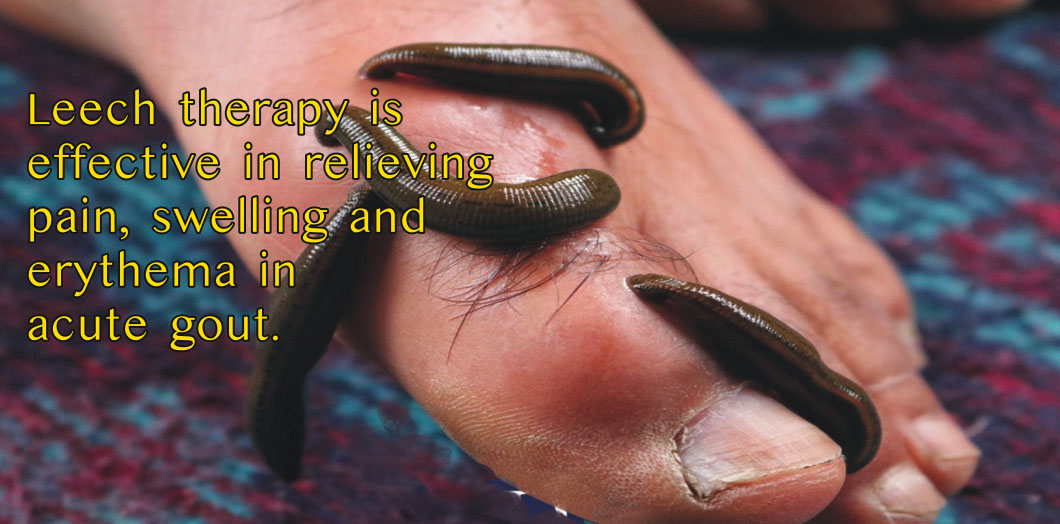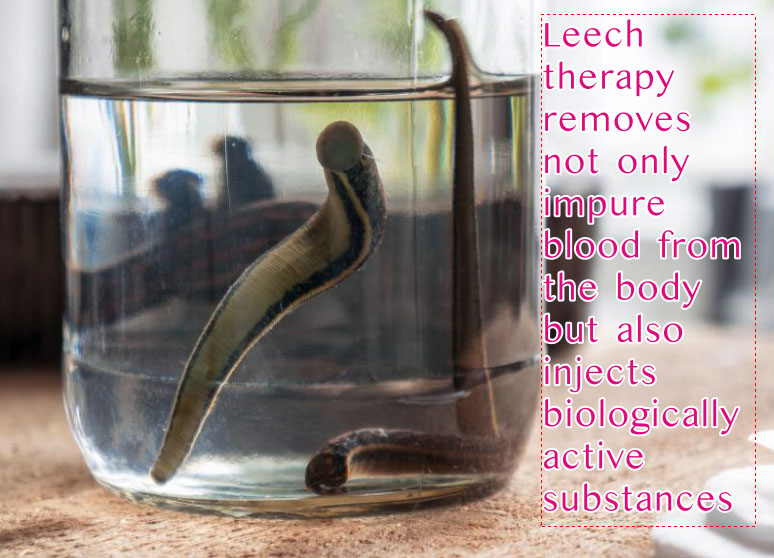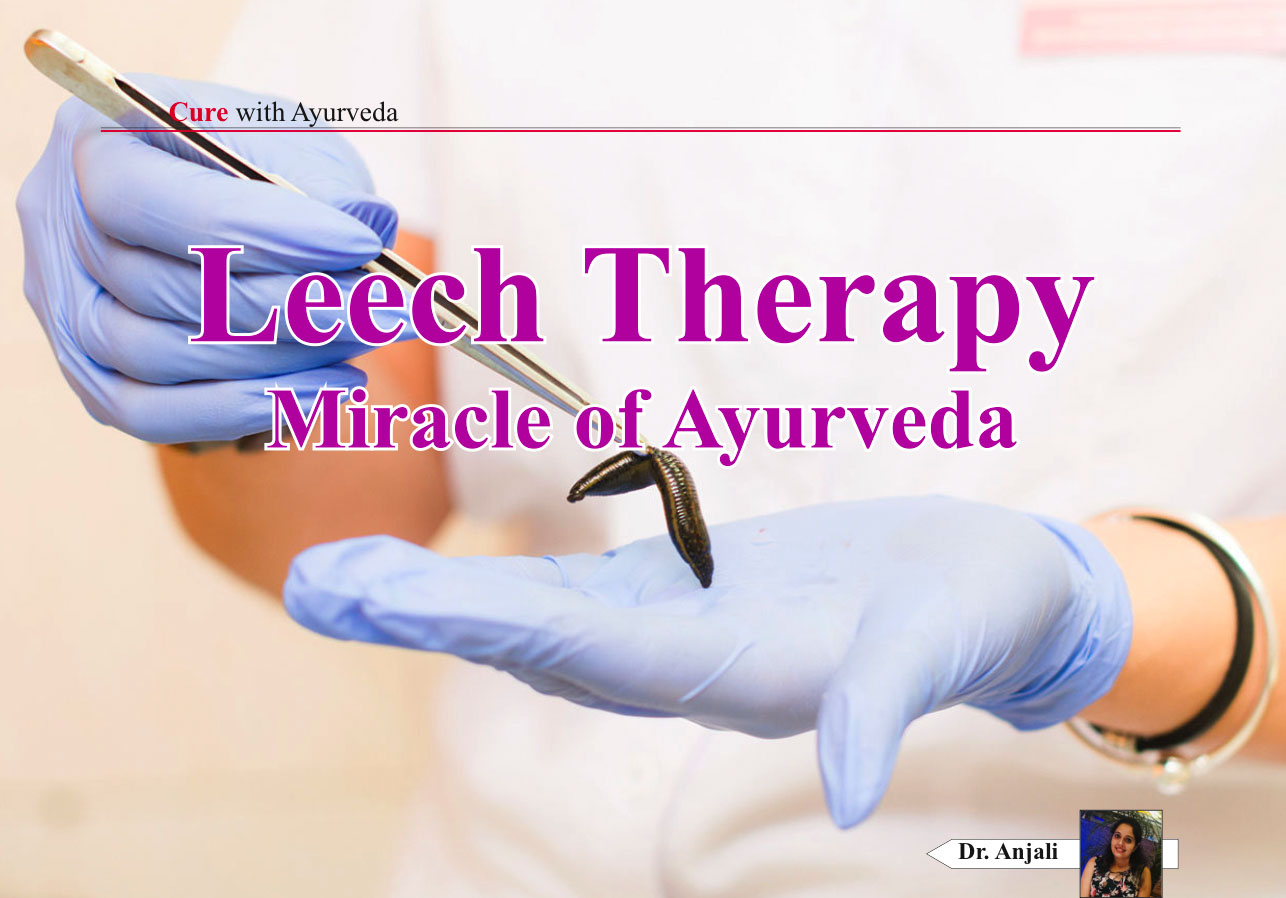Leech therapy is considered as unique and most effective method of bloodletting. It is safely indicated in all people including the patients having poor threshold to pain. Medicinal leech is effective in the management of complicated varicose veins. It heals ulcers, decreases the oedema and limb girth and reduces hyperpigmentat-ion. Diabetic ulcer is an open sore wound that occurs in the patients of diabetes and is commonly located in foot. Leech therapy is effective in the management of diabetic foot ulcer. Leech therapy also named as Hirudo therapy has been known from the time of extreme antiquity and is still alive nowadays. This fact testifies its efficiency in healing various kinds of diseases.
Ayurveda can be defined as a system which uses the inherent principles of nature to help maintain health in a person by keeping the individual's body, mind and spirit in perfect equilibrium with nature. Leech therapy is one of such gifts to mankind. Medicinal leeches had a place in the doctor’s medical kit for centuries because they have proven themselves often to be the most effective treatment. Bloodletting is a parasurgical procedure directed for the treatment of blood-borne diseases along with many surgical conditions. Leech therapy has been in practice since ancient time. Acharaya Sushruta, the Father of Indian Surgery has explained in detail about Leech therapy for the purpose of bloodletting. It is considered as unique and most effective method of bloodletting. It is safely indicated in all people including the patients having poor threshold to pain. According to Ayurveda, Leech is used to expel out the vitiated blood safely, quickly and effectively. From modern perspective, the saliva of leech contains about hundred biological active substances. They not only suck the impure blood but also leave behind their saliva, which contains enzymes that help to cure the disease.
The treatment of disease conditions with medicinal leeches is termed as Hirudotherapy (Jalaukavacharana). Hirudotherapy is one of the most ancient healing methods documented in the history of medicine. The word leech comes from an old English word ‘laece’ meaning ‘physician’. The word later became Leech. In Medieval England, leeches were linked with healing because of the etymology of the word. As per Ayurveda, Leech therapy is a procedure and Acharya Sushruta has described Leech under the heading of Anushastra (parasurgical procedures). It is considered as a very effective method because the vitiated ‘Doshas’ are removed from the body without using any instrument.
Types of Leech
Ayurveda has mentioned two groups of leeches -
• Poisonous
• Non-poisonous
Poisonous Leeches
Leeches born in dirty water, in areas where dead fish, frog and snake putrify with their excreta, those which are red, white or very black in colour, which are over active, stout and slimy, having varied rainbow like lines on their back are poisonous and should be rejected.
Non-poisonous Leeches
Leeches born in clean water are non poisonous. They are bluish black in colour like algae and are round .Their back is dark and belly is yellowish.

Advantages of Leech Therapy
• Faster result
• Cost effective
• Rare complications
• Most delicate therapy
• Acts on deeper layers of body
• Greater reduction in the symptoms
• Can be used for all age groups. Can be used for those who are have a low willpower. As these persons are physically and mentally tender , no higher grade of therapies can be done on them. In such cases leech therapy is highly effective.

Indications of Leech Therapy
• Diseases of veins
Leech therapy has been proven to help patients suffering from venous diseases. Medicinal leech is effective in the management of complicated varicose veins. It heals ulcers, decreases the oedema and limb girth and reduces hyperpigmentation. It is also used to treat post phlebitis syndrome in which venous valves are obliterated by deep vein thrombosis.
• Peripheral vascular diseases
It is a blood circulation disorder that causes blood vessels outside the heart and brain to become narrow, blocked and produce spasms. Leech therapy can be effective in management of peripheral vascular diseases.
• Diabetic foot ulcer
It is an open sore wound that occurs in the patients of diabetes and is commonly located in foot. Leech therapy is effective in the management of diabetic foot ulcer.
• Non healing ulcer
Its application is significantly effective in pain management in the treatment of non-healing ulcers.
• Gout
It is a complex form of arthritis that causes severe attacks of pain , swelling ,redness and tenderness in joints .Leech therapy is effective in relieving pain, swelling and erythema in acute gout.
• Tenosynovitis
It is the inflammation of a tendon and its sheath. Leech therapy is the best alternative therapy that can be used to treat tenosynovitis that surpasses the pharmacological treatment with painkillers.
• Vitiligo
It is long term skin condition characterised by patches of depigmented skin. Leech therapy is effective in preventing progression and inducing repigmentation of fast spreading vitiligo without any associated side- effects.
• Eczema
Eczema is a condition where patches of skin become inflamed, itchy, cracked and rough .Bloodletting by making use of leeches is an effective , time saving, affordable and acceptable treatment in eczema.

Contraindications of Leech Therapy
Leech Therapy cannot be applied in all the patients and it is not recommended under the following medical conditions and diseases.
• Hemophilia
• Hypotension
• Severe anaemia
• During chemotherapy
• Individuals with HIV infection
• Severe allergy to foreign proteins
• Anticoagulant medication eg. Warfarin, Heparin
• People who are on immuno suppressive medication
• Erosive gastritis and potential gastrointestinal bleeding
Procedure of Leech Therapy
Pre procedure
Fresh leeches are taken and a mixture of turmeric paste in water is applied upon them. Site for leech therapy is the affected area which is cleaned with water.
Procedure
The active leech is made to suck on skin of affected area. The leech, when it starts sucking the blood, elevates its neck assuming the shape of a horse shoe.
Once a leech starts sucking the blood, it is covered with wet gauze. When itching or pricking pain is produced at the site of application it is inferred that the leech is now sucking the pure blood (after having sucked the vitiated blood). When sucking pure blood the leech is removed. If it does not withdraw, a little turmeric powder or common salt powder is sprinkled on the sucking part of the leech.
Post Procedure
After it falls off, the body of leech is sprinkled with turmeric. Held at its tail end by thumb and fingers of the left hand its body is kneaded slowly in the downward direction with thumb and fingers of the right hand which makes it vomit all the blood it has consumed. Site is mopped with cotton. Warm compresses with Triphla decoction are given. This conceptual blood letting procedure is mentioned in ayurveda to cure various diseases like skin diseases, blood disorders, alopecia, filariasis etc. Leech therapy, also named as Hirudo therapy has been known from the time of extreme antiquity and is still alive nowadays. This fact testifies its efficiency in healing various kinds of diseases.
Conclusion
Leech therapy removes not only impure blood from the body but also injects biologically active substances which help to manage various disorders. It is effective, less costly and short time procedure. This approach is very useful in many acute and chronic disorders without side effects.
Dr. Anjali
Assistant Professor,
Department of Shalakya Tantra,
Dayanand Ayurvedic College, Jalandhar.
dranjali30j@gmail.com Mob.: +91 8126089177







 Dec 2024
Dec 2024
 May 2024
May 2024
 September 2022
September 2022
 April 2022
April 2022
 October 2020
October 2020
 Jan 2020
Jan 2020
 June 2019
June 2019
 January-February 2019
January-February 2019
 Augest-September
Augest-September
 April 2018
April 2018
 November 2017
November 2017
 June 2017
June 2017
 November 2016
November 2016
 September 2015
September 2015
 March 2015
March 2015
 July 2014
July 2014
 January 2014
January 2014
 July2013
July2013
 March 2013
March 2013
 May 2012
May 2012
 May 2011
May 2011
 Sep 2010
Sep 2010
 Jun 2010
Jun 2010
 Feb 2010
Feb 2010
 December 2009
December 2009
 August 2009
August 2009
 June 2009
June 2009
 Feb 2009
Feb 2009
 December 2008
December 2008
 October 2008
October 2008
 March 2008
March 2008
 July 2008
July 2008
 May 2008
May 2008